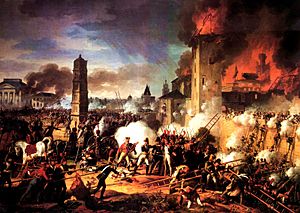Battle of Ratisbon facts for kids
Quick facts for kids Battle of Ratisbon |
|||||||
|---|---|---|---|---|---|---|---|
| Part of the War of the Fifth Coalition | |||||||
 Marshal Lannes leads the storming of the citadel at the Battle of Ratisbon, as painted by Charles Thévenin. |
|||||||
|
|||||||
| Belligerents | |||||||
| Commanders and leaders | |||||||
| Strength | |||||||
| 37,000-72,000 | 26,000-78,000 | ||||||
| Casualties and losses | |||||||
| 1,000–1,500 | 8,900 | ||||||
The Battle of Ratisbon, also known as the Battle of Regensburg, happened on April 23, 1809. It was part of the Napoleonic Wars, a series of major conflicts in Europe. This battle was fought between the French army, led by Napoleon I, and the Austrian army, led by Archduke Charles.
The city of Ratisbon (today called Regensburg) was very important. It had a key stone bridge over the Danube River. This bridge allowed the Austrian army to escape into Bohemia after earlier battles. During the fight, a French general named Marshal Jean Lannes bravely led his soldiers up ladders to attack the city walls. Napoleon himself was hit in the ankle by a small cannonball, but he wasn't badly hurt.
Getting Ready for Battle
After winning a battle at Eckmühl on April 22, Napoleon decided to stop his army about 18 kilometers south of Ratisbon. The Austrians had taken control of Ratisbon two days before.
That night, the main Austrian army started moving their heavy equipment across the important stone bridge in the city. They also quickly built a temporary bridge, called a pontoon bridge, about 2 kilometers downstream. This was for their soldiers to cross the river. Five groups of Austrian soldiers stayed behind to defend the city. About 6,000 cavalry (soldiers on horseback) and some infantry (foot soldiers) guarded the hills outside.
The Battle Begins
At dawn on April 23, the French army moved towards Ratisbon from two sides. General Louis-Pierre Montbrun came from the southwest, and Napoleon's troops came from the south. Around 9:00 AM, about 10,000 French cavalry, led by General Étienne Nansouty, started fighting the Austrian cavalry.
The Austrian cavalry fought hard for almost three hours. They helped the rest of their army escape across the bridges. After a while, the Austrian cavalry managed to slip away.
The French then found the pontoon bridge. However, the last Austrian defenders managed to cut the ropes holding it. This stopped the French from using it to cross the river.
By noon, the French foot soldiers arrived and surrounded the city's old defenses. Marshal Lannes was put in charge of capturing the city. He ordered cannons to fire at the walls, while light infantry fought Austrian soldiers in the areas outside the city.
Two attempts to storm the main gates failed, and the French lost many soldiers. At 3:00 PM, General Henri Gatien Bertrand, who was in charge of the engineers, used heavy cannons to blast a hole in the wall near the Straubing gate.
Napoleon walked to see the hole in the wall. While he was there, a small cannonball hit him in his left foot. It wasn't a serious injury, but it caused a bruise. He quickly got back on his horse and rode around to show his worried soldiers that he was fine.
Three small groups of French soldiers tried to climb the damaged wall using ladders, but they failed. Lannes's men were hesitant to try a fourth time. Lannes became very frustrated. He grabbed a scaling ladder himself and shouted, "I will let you see that I was a grenadier before I was a marshal and still am one!" He started to move forward with the ladder, but his assistants stopped him.
His soldiers, feeling ashamed by their leader's actions, then rushed forward. The fourth attack group successfully climbed the walls. Within minutes, French soldiers were pouring into Ratisbon.
Fighting continued fiercely in the streets for several hours. The French eventually took control of the southern part of the city. The bridge was bravely defended by a group of Austrian soldiers until about 9:00 PM. They then left their positions, and the French reached the northern area called Stadt-am-Hof. The last 300 Austrian defenders surrendered soon after.
What Happened Next
The French army had about 1,500 to 2,000 soldiers killed or wounded, including Napoleon. The Austrians lost at least 6,000 soldiers who were killed, injured, or captured.
After the battle, Napoleon sent Marshal Louis Davout to guard the north side of the Danube River. This victory allowed Napoleon to continue his march towards Vienna, which led to another important battle called the Battle of Aspern-Essling.
In Books
The poem "Incident of the French Camp" by Robert Browning tells a story that might be made up, but it's set during this battle.


